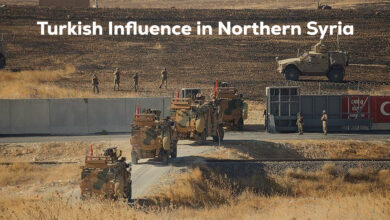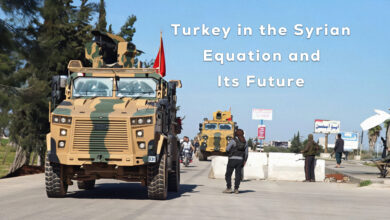The Congestion in the Eastern Mediterranean and the Struggle over Energy
Shervan Seif al-Din

There is no doubt that the Syrian crisis that erupted on the fifteenth of March 2011, was due to reasons related to the economic situation and political freedoms in the country. The Syrian people were hoping for freedom and dignity, which they originally came out for, but they were met with excessive violence from the regime. The popular movement continued peacefully for more than six months in the hope of changing the Syrian regime’s methods in dealing with the popular movement and demands, but to no avail. The repressive machine of the controlling authorities of the state was strict in defining its vision for the solution, limiting these protests and demands, using violence and eliminating them by force and nothing but force, without leaving any room for dialogue or discussions aimed at framing and solving the problem appropriately. Over time, as the other party also started using force and weapons, things became more complicated, especially with the increase in Syrian bloodshed, which was like a mercy shot on the peaceful revolution and the legitimate demands of the people. This led to a radical change in the course of the revolution called for by the Syrian people, and Syria began to enter the maze of civil war in its form and content. Accusations started flying from each side to the other, targeting civilians, infrastructure, cutting off roads, setting up checkpoints, and taking tolls; thus, chaos spread throughout the country, leading to a state of disorder and instability.
It’s no secret to anyone that the intervention of foreign powers in the Syrian crisis has further complicated the prospects for a political solution. Of course, this intervention won’t come for free or due to ethical or humanitarian reasons. On the contrary, it’s definitely driven by geopolitical agendas and economic interests. The exploration of natural gas in the Eastern Mediterranean is one of the key reasons prompting Russia in particular, and Western countries in general, to intervene in the Syrian conflict. This exploration holds strategic importance in shaping regional policies and influencing international relations, alliances, and economic partnerships. The competition for control over the Eastern Mediterranean gas reserves has intensified international rivalries, both directly and indirectly through local allies. The global power struggle for dominance over crucial chokepoints and geopolitical regions has heightened competition among major corporations as well. The estimated gas reserves in the Mediterranean Basin are projected to be the second largest in the world after those in Western Siberia. This has fueled competition between the two main power poles – the United States and its allies on one side, and the Russian Federation and its allies on the other. In March 2010, the US Geological Survey conducted an assessment of undiscovered oil and gas resources in the Nile Delta adjacent to Egypt, which is expected to hold the largest untapped reserves, and in the Levant Basin in the Eastern Mediterranean, covering the maritime areas facing Gaza, Lebanon, Syria, and Cyprus, totaling around 83,000 square kilometers. The assessment followed a methodology based on available geological and commercial information about wells and production fields in the region. The gas reserves in the Eastern Mediterranean Basin were estimated to be approximately 5.1% of the world’s total reserves. The assessment indicated that the region contains an average of 879 million barrels of oil and 286.2 trillion cubic feet of gas. A report from the Berlin-based Friedrich Ebert Foundation projected that Syria could rank third globally in gas production if it manages to maximize its production capacity. Consequently, all these figures and statistics are fueling the appetites of regional and international powers to access and exploit these warm waters rich in natural resources.
The agreements between the Russian side and the Syrian government began in 2017 when the government contracted with a Russian security company to protect oil and gas facilities from ISIS in exchange for 25% of the profits. Russia then acquired oil and gas fields in northern Damascus countryside in the locations of Qarat and Birj through a number of companies (Mercury – Vela – STG, among others), and four fields to the east of Homs, and fields existing and discovered off the Syrian coast, through contracts signed with the Syrian government granting them exclusive rights to produce and explore gas and oil. The agreements also include the rehabilitation of oil wells and their infrastructure, providing energy consultations, technical training, with the value of these agreements reaching 40 billion dollars. According to official newspapers from Damascus, two contracts were signed by the Syrian Ministry of Oil and Mineral Wealth with the Russian companies Capital Limited and East Med Amrit. The first contract grants Capital Limited exclusive rights to explore for oil and gas and develop it in the first maritime block in Syria’s economic zone and territorial waters in the Mediterranean Sea off the coast of Tartus province to the southern Syrian-Lebanese maritime borders, covering an area of 2250 square kilometers. The contract is divided into two periods: the first for exploration for 48 months, extendable for an additional 36 months, and the second period for development for 25 years, extendable for 5 years, with profit sharing dependent on global oil and gas prices and future production quantities. The second contract was signed after an exploration contract in the second block of the economic zone in Syrian territorial waters in the Mediterranean Sea, extending from north Tartus to south Banias over an area of 2190 km, with East Med Amrit company. Additionally, a contract was signed to lease the Tartus port to the Russian company “STG Engineering” for 49 years, along with the Arab Gas Pipeline, the only current link between several Arab countries in the region, established in 2008 with a length of 1,200 km after about 5 years of work, stretching from the Egyptian city of Al-Arish to the Jordanian city of Aqaba, then to the city of Al-Rehab in northern Jordan, through Syrian territory to the city of Homs in Syria, then to the city of Deir Ammar in Lebanon, and Banias on the Syrian coast.
All the numbers and agreements, whether secret or public, regarding the importance of the Syrian coast to the major powers cannot be ignored. Each party is demanding its share. Understanding the hidden aspects of the situation reveals the reason for prolonging the Syrian crisis, as well as the reason for the lack of agreement among major players to sit down and find a humane solution to the suffering of the Syrian citizens.




